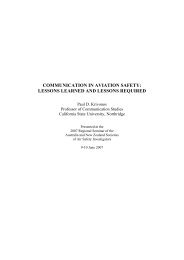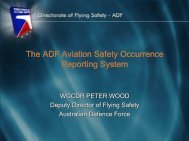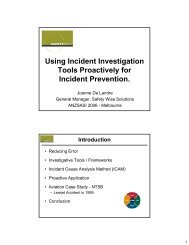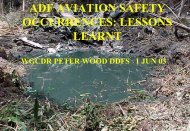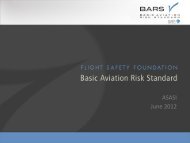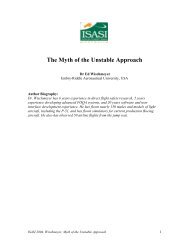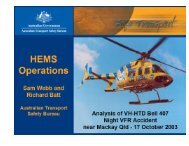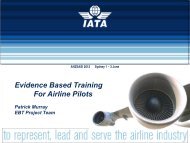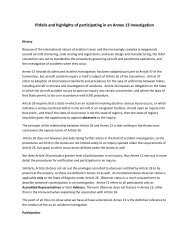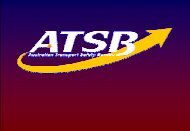Threat and Error Management (TEM) and High Altitude ... - ASASI
Threat and Error Management (TEM) and High Altitude ... - ASASI
Threat and Error Management (TEM) and High Altitude ... - ASASI
Create successful ePaper yourself
Turn your PDF publications into a flip-book with our unique Google optimized e-Paper software.
A/NZSASI<br />
June 2007<br />
<strong>Threat</strong> <strong>and</strong> <strong>Error</strong> <strong>Management</strong> (<strong>TEM</strong>)<br />
<strong>and</strong> <strong>High</strong> <strong>Altitude</strong> Operations<br />
CAPT Dave Carbaugh<br />
Chief Pilot Flight Operations Safety<br />
BOEING COMMERCIAL AIRPLANES
‣ Statistics - History<br />
‣ The 1998 Upset Training Aid<br />
‣ <strong>High</strong>lights of the Changes<br />
‣ <strong>High</strong> <strong>Altitude</strong> Maneuvers<br />
‣ Upset Recovery Techniques
West Caribbean<br />
MD-82<br />
Maracaibo, Venezuela<br />
16 August 2005
West Caribbean MD-82<br />
16 August 2005<br />
• Chartered flight from Panama City to Martinique, impact<br />
site in a rural area near the town of Machiques, , Venezuela.<br />
152 pax (all French Citizens); 8 crew (Colombian) – all fatal<br />
• Shortly before entering Venezuelan airspace, crew began to<br />
request lower altitudes (from FL330).<br />
• Crew indicated to ATC that they had ‘dual engine<br />
flameout’.<br />
• Last contact from crew is at FL140 <strong>and</strong> descending;<br />
airplane not controllable.<br />
• Recorders were read out by the BEA in France.<br />
• French <strong>and</strong> Venezuelan authorities conducting separate<br />
investigations.
ISSUES:<br />
‣ SPEED DECAY FOLLOWED BY AERODYNAMIC<br />
STALL AFTER LEVELING AT CRUISE ALTITUDE<br />
‣ RADAR DATA: VERY HIGH RATE OF DESCENT<br />
FROM FL 330 TO 14,300 - RADAR CONTACT<br />
LOST<br />
‣ CONVECTIVE ACTIVITY IN VICINTITY OF THE<br />
ACCIDENT
Stick Shaker Events<br />
Moderate turbulence - Encountered at FL390<br />
(ON TOP OF CLOUDS VMC) associated with convective clouds<br />
(CB) around <strong>and</strong> heavy crosswind (60-90 knots). Weather radar<br />
was on <strong>and</strong> we noticed clouds below <strong>and</strong> radar returns<br />
indications of the presence of CB`s. The cabin crew were seated<br />
<strong>and</strong> seatbelt sigh had been switched on. IAS tape was fluctuating<br />
+/- 15 knots of the comm<strong>and</strong> speed <strong>and</strong> the underspeed limiting<br />
symbol appeared in the MCP IAS/MACH display (comm<strong>and</strong><br />
speed cannot be reached) few times. At this point we hit severe<br />
turbulence in VMC <strong>and</strong> "stick shaker" had been activated for 1<br />
second <strong>and</strong> aircraft banked to the left side. The autopilot <strong>and</strong><br />
autothrottle were disengaged immediately <strong>and</strong> descent to FL370<br />
initiated. Moderate turbulence continued for the next 10 minutes<br />
at FL370.
Stick Shaker Events<br />
60 MILES BEFORE A T/STORM REQUESTED 15 DEGS RIGHT FROM ATC TO AVOID TO<br />
INCREASE SEPARATION TO APPROX 30 MILES. ATC GRANTED REQUEST. PASSED<br />
ABEAM T/STORM ABOUT 30 MILES TO EAST AT FL380. TAILWIND DROPPED AND<br />
SPEED RAPIDLY WASHED OFF. MCT APPLIED INTIALLY. WING AND ENG ANTI-ICE<br />
IMMEDIATLY SWITCHED ON AS ICE SEEN RAPIDLY FORMING ON WIPERS AND<br />
WINDSCREEN. TOLD ATC WE HAD TO DESCEND AND COULD NOT MAINTAIN 380<br />
AND THEY CLEARED US TO DESCEND FL240. WHILE LEAVING FL380 STALL<br />
WARNING MOMENTARILY WENT OFF AND AERODYNAMIC BUFFET FELT WITH<br />
ACOMMPANYING SEVERE TURBULANCE. STOPPED ALMOST IMMEDIATLY WITH<br />
FURTHER PITCH DOWN AND THRUST. NORMAL FLIGHT PARAMATERS REGAINED<br />
BEFORE FL360. LEVELLED OFF AT FL360 AND FLIGHT CONTINUED NORMALLY. PIREP<br />
MADE TO ATC OF SEVERE ICING IN THE AREA AT FL380. OTHER PARAMETERS<br />
NOTED IMMEDIATLY AFTER THE EVENT: SAT -56DEGS. FMC CRZ PAGE OPT/MAX<br />
375/398. WIND 180/50 IMMEDIATLY BEFORE INCIDENT. NOTED AT 220/22 IMMEDIATLY<br />
AFTER EVENT.
Stick Shaker Event<br />
DECAYING AIRSPEED<br />
MAX THRUST <br />
STICK SHAKER<br />
A/P REMAINS<br />
ENGAGED<br />
A/T<br />
DISCONNECTED
HIGH ALTITUDE<br />
MANEUVERING<br />
PERFORMANCE
‣ Industry Team Effort<br />
• Manufacturers<br />
• Airlines<br />
• Specialty Organizations
‣ Aimed at Large Transport<br />
Category Airplanes
‣ Historically Divided Between Mechanical<br />
<strong>and</strong> Flight Crew Caused<br />
NORMAL MENU RESETS NON -NORMAL MENU<br />
PREFLIGHT<br />
OXYGEN PANEL<br />
PASSENGER SIGNS<br />
FLIGHT INSTRUMENTS<br />
AUTOBRAKE SELECTOR<br />
PARKING BRAKE<br />
FUEL CONTROL SWITCHES<br />
SET<br />
SET<br />
SET<br />
RTO<br />
SET<br />
CUTOFF<br />
NORMAL<br />
I<strong>TEM</strong><br />
OVRD<br />
CHKL<br />
OVRD<br />
CHKL<br />
RESET<br />
NORMAL MENU RESETS NON -NORMAL MENU<br />
FIRE ENG L<br />
F i re de t ec t ed i n l e f t eng ne . i<br />
LEFT AUTOTHROTTLE ARM SWITCH.........OFF<br />
LEFT THRUST LEVER..................CLOSE<br />
1<br />
LEFTFUEL CONTROL SWITCH..........CUTOFF<br />
LEFTENGINE FIRE SWITCH.............PULL<br />
I F FIRE ENG L message r emai ns dep l oyed :<br />
2<br />
XXLEFTXENGI NEXFIREXSWITCH.........ROTATE<br />
XXXXRo<br />
tateXtoXtheXstopX<strong>and</strong>Xhol dXforX1XXX<br />
XXXXsecond.XXXXXXXXXXXXXXXXXXXXXXXXXXXXX<br />
3<br />
NORMAL<br />
I<strong>TEM</strong><br />
OVRD<br />
NOTES<br />
CHKL<br />
OVRD<br />
CHKL<br />
RESET<br />
NON-<br />
NORMAL
‣ Variable Situations <strong>and</strong> Outcomes<br />
‣ Rare Events so Crews Became Startled
‣ Crews Sometimes Used Improper Inputs to<br />
Recover<br />
‣ Crews Training Generally Left Them<br />
Unprepared to Deal with Upsets <strong>and</strong> Recover
‣ Basic Flaws in Knowledge <strong>and</strong> Training Became<br />
Evident<br />
‣ Many Accidents were Recoverable with Proper<br />
Training
‣ Lack of Consensus on Content, Scope, Types of<br />
Training <strong>and</strong> Underst<strong>and</strong>ing<br />
‣ Need for St<strong>and</strong>ardization
Continued Accidents <strong>and</strong><br />
‣ Incidents<br />
‣ Some Important Upset<br />
Issues were Identified
‣ Tragic Accident in New York<br />
‣ Update Information in the Training Aid<br />
‣ Need to get the Word Out!
Pilot-Comm<strong>and</strong>ed Sideslip<br />
‣ Roll due to sideslip<br />
‣ “Large aggressive control reversals can<br />
lead to loads that can exceed structural<br />
design limits”
Pilot-Comm<strong>and</strong>ed Sideslip<br />
• Except crosswind takeoff <strong>and</strong> l<strong>and</strong>ings -<br />
rudder, yaw damper, turn coordinators are to<br />
keep sideslip as close to zero as possible
Flight Control <strong>and</strong> Other Anomalies<br />
‣ Stall Warnings on Takeoff<br />
• Incorrect V speed<br />
• Incorrect Flap or Stabilizer Position<br />
• Malfunctioning stall warning system<br />
• Shift in CG during takeoff
Flight Control <strong>and</strong> Other Anomalies<br />
‣ Adjust the Flight<br />
Profile<br />
• Induced drag<br />
• Shifts in CG
Directional Maneuvering<br />
‣ Rudder Limiters<br />
• Limit authority<br />
• Two basic designs<br />
• Structural capability
Directional Maneuvering<br />
‣ “Dutch Roll”<br />
• Overshoots of Sideslip<br />
• Yaw Damper inoperative
Simulator Training<br />
‣ Limitations<br />
• Basic Fundamentals<br />
• Realities of simulation<br />
• Complexity
Simulator Training<br />
‣ Fidelity Issues<br />
• Alpha <strong>and</strong> Beta Limits<br />
• Reactions <strong>and</strong> Responses
STRATEGIES
Upset Recovery<br />
REVIEW<br />
• Causes of Airplane Upsets<br />
• Swept-wing wing Airplane<br />
Fundamentals<br />
• Airplane Upset Recovery<br />
Techniques<br />
51
What is “Airplane Upset”<br />
52
Causes of Airplane Upsets<br />
Environmentally induced<br />
‣ ‣ Systems anomalies induced<br />
‣ Pilot induced<br />
‣ A combination of all three<br />
54
Environmental Causes<br />
• Turbulence<br />
• Clear air turbulence<br />
• Mountain wave<br />
• Windshear<br />
• Microbursts<br />
• Wake turbulence<br />
• Airplane Icing<br />
55
System Anomalies Induced<br />
These causes primarily involve:<br />
• Flight Instruments<br />
• Autoflight systems<br />
• Flight controls <strong>and</strong> other<br />
anomalies<br />
56
Pilot Induced Causes of Upsets<br />
• Instrument misinterpretation or slow cross-<br />
check<br />
• Inattention <strong>and</strong> distraction from primary cockpit<br />
duties<br />
• Vertigo or spatial disorientation<br />
• Improper use of airplane automation<br />
57
STRATEGIES<br />
Review of Recovery Techniques<br />
• Nose high, wings level<br />
• Nose low, wings level<br />
• <strong>High</strong> bank angles<br />
• Nose high<br />
• Nose low<br />
• Consolidated techniques for<br />
• Nose high<br />
• Nose low<br />
58
STRATEGIES
Startle Factor<br />
60
B717 – TEST FLIGHT
B717 – TEST FLIGHT
B717 – TEST FLIGHT
“Task Saturation”<br />
64
Use of Full Control Inputs<br />
65
Non-intuitive Factors<br />
66
Stall Recovery<br />
67
STRATEGIES<br />
Stall Recovery<br />
68
Recovery Techniques<br />
(cont)<br />
•Stall characteristics<br />
• Buffeting<br />
• Lack of pitch authority<br />
• Lack of roll control<br />
• Inability to arrest descent rate<br />
69
STRATEGIES
Nose-<strong>High</strong>, Wings Level
STRATEGIES
Nose-high, Wings Level<br />
Recovery Techniques<br />
• Recognize <strong>and</strong> confirm the situation<br />
• Disengage autopilot <strong>and</strong> autothrottles<br />
• Apply as much as full nose-down elevator<br />
• Reduce thrust (for underwing-mounted engines)<br />
• Roll to obtain a nose-down pitch rate<br />
• Complete the recovery<br />
• Approaching horizon, roll to wings level<br />
• Check airspeed <strong>and</strong> adjust thrust<br />
• Establish pitch attitude<br />
73
Nose-Low, Wings Level
STRATEGIES
Nose-Low, Wings Level<br />
• Recognize <strong>and</strong> confirm the situation<br />
• Disengage autopilot <strong>and</strong> autothrottle<br />
• Recover from stall, if necessary<br />
• Recover to level flight<br />
•Apply nose-up elevator<br />
•Apply stabilizer trim, if necessary<br />
Adjust thrust <strong>and</strong> drag, as necessary
<strong>High</strong> Bank Angles<br />
• Lift vector<br />
• Lateral control<br />
77
‣ Nose-high<br />
<strong>High</strong> Bank Angles<br />
Bank angle helps reduce high<br />
pitch attitudes<br />
Must consider energy<br />
management<br />
Nose-low<br />
‣ Prompt action required<br />
Bank angle greater than 90<br />
degrees considerations<br />
78
Conclusion<br />
‣ Know the causes of airplane upsets -<br />
avoid them, when possible<br />
‣ Be familiar with the flight dynamics<br />
<strong>and</strong> aerodynamics of your airplane<br />
‣ Know the recovery techniques<br />
79



